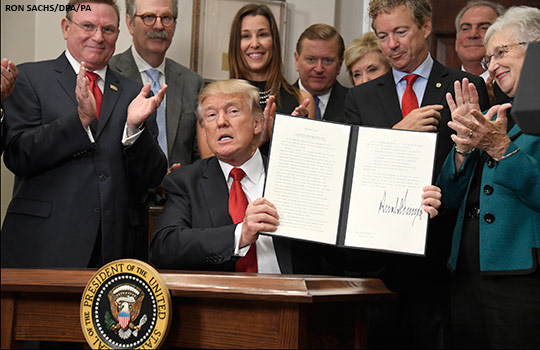As a presidential candidate and as president of the US, Donald Trump repeatedly claimed that “Obamacare is imploding.” For months, the Trump Administration has tried to make that prediction come true. Thanks to the efforts of many healthcare advocates and policymakers, the Affordable Care Act (aka Obamacare, or the ACA) hasn’t imploded. But the Trump Administration may instead succeed in quietly killing the ACA with 1,000 cuts.
Trump’s first efforts were to undermine confidence in the ACA and reduce the number of Americans signing up. Immediately after the inauguration, the Trump Administration stopped all ads and outreach in the final days of open enrollment, and at the same time boasted that Obamacare would be repealed.
The next cut was crucial: announcing that the government would not enforce the mandate that all consumers must have health insurance. The mandate had been enforced by requiring taxpayers to pay a penalty if they admitted they had not purchased health insurance. Although the penalties were relatively modest ($95 in the first year and up to about $2,100 in 2017), it was a clear incentive to buy health insurance. Without it, companies knew that younger, healthier consumers were less likely to buy health insurance, thus increasing the cost for those who do sign up and decreasing the incentives for insurance companies to participate in ACA. Goal achieved: companies starting announcing they would drop out of several locations, leaving several counties without any insurance options.
After Congressional repeal efforts and other threats by Trump failed to kill the ACA, the Trump Administration announced that they would drastically cut funding to states for the “navigators” that help consumers sign up for Obamacare. Navigators are especially important for consumers that don’t know how to use a computer, are confused by terms such as “co-payments” or “deductibles”—in other words, crucial in helping low income and less educated consumers find and sign up for the policies that they can afford. The justification was that many of these programs had previously promised to sign up more customers than they actually did. That excuse was ludicrous, of course, given the billions in cost overruns of Department of Defense and other contracts that the federal government renews year after year. But as final funding decisions were announced in September, it became clear that even the most successful navigator programs were being slashed, some by as much as 92%. Surprisingly, red and purple states, such as Louisiana, Georgia, Nebraska, the Dakotas, New Jersey, and Ohio, are among those drastically cut.
Another small cut (literally and figuratively) designed to undermine the ACA was the announcement that the sign up period would be shortened to only 45 days—about half the length of the sign-up opportunities for the previous 3 years. Adding to the inconvenience, the website would go down for 12 hours every Sunday for “maintenance” during those 6 weeks.
Trump then announced several other efforts to undermine coverage requirements in the ACA, including a weakening of the requirement to provide free contraceptives. In addition to harming women, this would make ACA coverage less attractive to many young, healthy women—the types of consumers that the ACA needs to survive.
The fatal cut?
The biggest cut of all came on Friday. For months, the Trump Administration threatened to stop paying insurance companies subsidies that were intended to help make ACA coverage more affordable. These are not subsidies that go directly to consumers—they are the “cost sharing reductions” that the federal government pays insurance companies on the condition that they reduce the out-of-pocket costs for ACA customers with household incomes between 100-250% of the federal poverty level.
Many Republicans opposed that threat, which scared away many insurance companies in different counties, but it wasn’t until it was clear that ACA insurance plans would nevertheless be offered in all counties in all 50 states in 2018 that President Trump detonated his bomb on Friday 13 October by announcing his Executive order to halt those $7 billion in payments. As a result of those cuts, insurance companies will immediately lose their subsidies for the rest of 2017, but can now choose to quit the ACA for 2018.
The American public, hospitals, pharmaceutical companies, insurance companies, and many state officials want the ACA to survive. Furious at the havoc this Executive Order would generate, 19 state attorneys general immediately challenged the Executive Order. Even more promising, Senators Lamar Alexander (R-Tenn) and Patty Murray (D-WA) have been working on a bipartisan compromise to shore up the ACA—and the incentive for them to succeed is certainly greater than ever.
Is compromise possible?
If you think the US is a democracy, you might think that bipartisan compromise is the way to get such a law passed. Unfortunately, in recent years, democracy has been rejected by Republican Speakers of the House, who usually follow the “Hastert Rule,” which only brings a bill to a vote if it could pass the House with just Republican votes. This makes bipartisan compromise impossible and Democratic votes irrelevant.
Speaker of the House Ryan knows that if he doesn’t follow the rule (it is not a law), he could lose the speakership. Of course, if he does follow it, and millions of Americans lose health insurance, the Republicans could easily lose their majority in the House in 2018.
So what’s next? A government shutdown in December to force a vote on a compromise bill? Fasten your seatbelts—it’s going to be a bumpy ride.
Diana Zuckerman, president, National Center for Health Research, Washington.
Competing interests: None declared.
